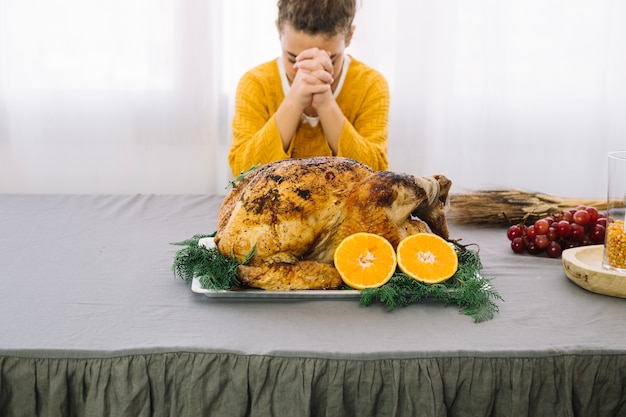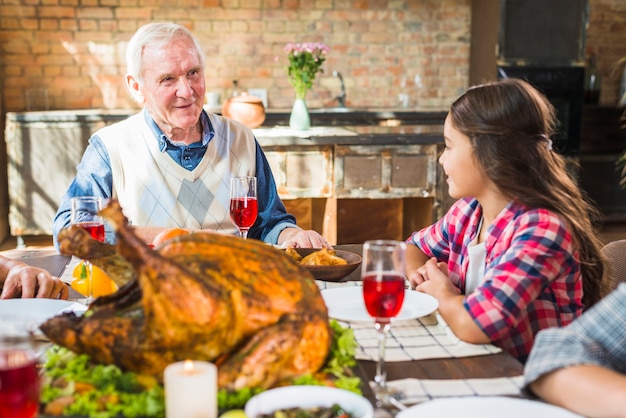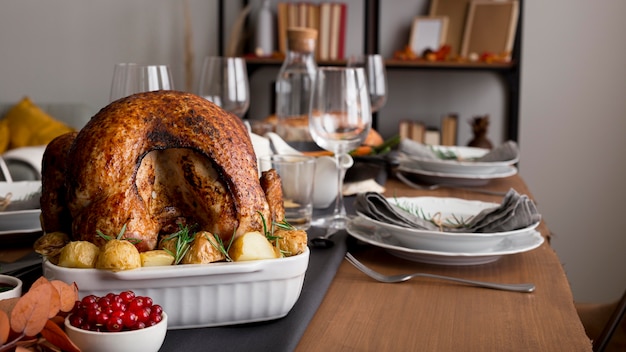(Part 1) Choosing the Right Turkey

Size Matters, It Really Does
First things first: size matters. You don't want a turkey that's too big for your oven (we've all been there, stuffing that last bit in awkwardly). And you definitely don't want one that's too small – imagine the disappointment when everyone's eyeing up the meagre bird.A good rule of thumb is about 1.5kg (3.3lbs) per person. That’s enough for everyone to have a decent slice, with a little bit leftover for sandwiches the next day. And if you’re feeling adventurous, ask your butcher for a free-range turkey – they have a more intense flavour, and well, you deserve a treat, right?
Appearance Counts
Now, let's talk about what to look for. Check the skin – it should be plump and taut, with a nice healthy colour. If it’s loose and dull, that’s a sign that the bird might not be as fresh as it could be. And while you’re at it, give the turkey a good sniff. A fresh bird will have a clean, pleasant smell. If it smells off, trust your nose and steer clear.Age Matters Too
A younger bird will be tenderer and easier to carve, so ask your butcher for a young one. You can tell the age of a turkey by looking at the breastbone. If it’s flexible, it’s a younger bird. If it’s hard and bony, it’s an older bird.(Part 2) Getting Ready to Roast

The Great Brine Debate
You might have heard about brining a turkey. Basically, you soak it in a salt solution before roasting. Some swear by it, claiming it makes the bird juicier and more flavorful. Others, like me, find it a bit of a faff. It's all a matter of personal preference, really. If you’re feeling adventurous, give it a go. But if you're short on time, don’t worry – a good roasting technique will still give you a delicious bird.Prepping the Turkey
Before you even think about sticking that bird in the oven, you need to give it a good prep. First things first, remove the giblets from the cavity – they’re usually packed inside. Then, give the turkey a good rinse under cold water and pat it dry with paper towels.Spatchcocking: The Game Changer
Here’s a tip that has changed my turkey-roasting game forever: spatchcocking. It’s basically flattening the bird by removing the backbone. This has two major benefits: it cooks more evenly and it reduces the roasting time, which is a real bonus if you're short on time.To spatchcock your turkey, you’ll need a good pair of kitchen shears. Cut along both sides of the backbone, then remove it entirely. Flatten the bird, breast side up, and you’re ready to season and roast.
Seasoning Your Bird
Remember the golden rule – less is more. A simple blend of salt and pepper is often enough to bring out the natural flavour of the turkey. You can add some herbs and spices, but don’t go overboard. You want to enhance the flavour, not overwhelm it. My personal favourite is a simple mix of rosemary and thyme.Getting That crispy skin
For that perfect golden-brown skin, you want to rub the bird with a little bit of oil. This will help the skin to crisp up beautifully. And, here’s a little trick from my grandmother: tuck some butter under the skin to give the meat an extra boost of flavour. This simple step can make a big difference!(Part 3) Roasting Your Turkey

Oven Temperature: Getting it Right
The oven temperature is key. You want it hot enough to cook the turkey through but not so hot that it burns the outside. I usually roast mine at 180°C (350°F).The Art of Timing
The time it takes to roast a turkey depends on its weight. A good rule of thumb is to allow 20 minutes per 450g (1lb) of turkey. So, a 4.5kg (10lb) turkey would take about 2 hours. But, remember, this is just a starting point. You need to make sure the turkey is cooked through.Don’t Forget the Thermometer
The best way to tell if the turkey is cooked through is to use a meat thermometer. Insert it into the thickest part of the thigh, avoiding the bone. The temperature should reach 85°C (185°F).Resting Time
Once the turkey is cooked, let it rest for at least 30 minutes before carving. This will allow the juices to redistribute, resulting in a more succulent and flavorful bird.(Part 4) Stuffing Your Turkey: A Controversial Topic
Stuffing, that quintessential Thanksgiving dish, is a matter of passionate debate. Should it go inside the bird or be cooked separately? I’m firmly in the camp of separate cooking. Why? Well, it's safer and it allows you to cook the stuffing to perfection without worrying about the turkey’s temperature.The Separate Stuffing Method
If you’re cooking stuffing separately, use a baking dish and bake it in the oven alongside the turkey. It will soak up the delicious turkey juices as it cooks. Just make sure you check it regularly to ensure it's cooked through.Stuffing Inside the Bird
If you're adamant about stuffing the turkey, be sure to cook it to an internal temperature of 74°C (165°F). The USDA recommends cooking stuffing separately for safety reasons, as the internal temperature of the stuffing may not reach a safe level if cooked inside the bird.Don’t Forget the Gravy
No turkey feast is complete without a rich, flavorful gravy. And the best gravy is made from the turkey pan drippings. Once you’ve removed the turkey, pour off the fat and deglaze the pan with a little wine or stock. Bring it to a simmer and thicken it with a slurry of flour and water.(Part 5) Leftovers: Not Just for Sandwiches
Okay, so your turkey is cooked, you’ve devoured the stuffing, and you’re probably stuffed yourself! But, there’s still the matter of leftovers. Don’t just think of boring turkey sandwiches. Get creative with those leftovers.turkey soup for the Soul
A delicious turkey soup is a great way to use up leftover turkey. You can add veggies, noodles, or rice for a hearty and satisfying meal.turkey salad Sandwiches
Try a turkey salad sandwich for a lighter option. Combine shredded turkey with mayonnaise, celery, onion, and your favourite seasonings.Turkey Curry for a Spicy Twist
Feeling adventurous? Try a turkey curry. The leftover turkey can be used in a variety of curries, from mild to spicy.(Part 6) Common Turkey Roasting Mistakes: Learn from My Blunders
Okay, so you’ve got all the basics down. But, let's be honest, we all make mistakes. I’ve certainly made my share of turkey roasting blunders. But don’t worry, you can learn from my experience.Overcrowding the Oven
One of the biggest mistakes people make is overcrowding the oven. Make sure there’s enough space around the turkey for the hot air to circulate properly. If you’re cooking other dishes, give them their own space.Cooking the Turkey Too Quickly
Remember, slow and steady wins the race. Don’t be tempted to cook the turkey at a higher temperature. It might cook faster, but it's likely to dry out the meat.Not Checking the Temperature
Don’t rely on visual cues alone. Always use a meat thermometer to ensure the turkey is cooked through.Forgetting to Rest the Turkey
Don’t skip the resting stage. Allowing the turkey to rest will ensure the meat is juicy and flavorful.(Part 7) Turkey roasting tips for the Perfect Bird
Now, I’ve shared some of my turkey roasting secrets with you, but there are a few more tips that can make all the difference.The Power of Butter
Remember that butter tip I mentioned earlier? It really makes a difference. Tucking some butter under the skin will keep the meat moist and flavourful.The Magic of Herbs
Don’t be afraid to experiment with herbs. Rosemary, thyme, sage, and parsley are all great choices for turkey. You can also use a pre-made blend of herbs.Cooking with Wine
Add a splash of wine to the turkey pan for extra flavour. White wine is a good choice for lighter dishes, while red wine is better for richer dishes.Dealing with Leftover Turkey
Don’t let leftover turkey go to waste! You can use it in soups, salads, sandwiches, or even pasta dishes.(Part 8) FAQs: Your Turkey Roasting Questions Answered
Let's address some common questions you might have about roasting your turkey.Q1: How do I tell if a turkey is cooked?
The best way to tell if a turkey is cooked through is to use a meat thermometer. Insert it into the thickest part of the thigh, avoiding the bone. The temperature should reach 85°C (185°F). You can also check the juices. If they run clear, the turkey is cooked. If they're still pink, it needs to cook a bit longer.
Q2: Can I stuff the turkey ahead of time?
It's generally not recommended to stuff the turkey ahead of time. The stuffing needs to be cooked to an internal temperature of 74°C (165°F). If you stuff the turkey ahead of time, the stuffing may not reach a safe temperature. It’s best to stuff the turkey just before roasting.
Q3: What should I do if the turkey is dry?
If your turkey ends up being a bit dry, there are a few things you can do. First, try adding some gravy. Second, you can shred the turkey and mix it with some mayonnaise, celery, onion, and seasonings to make a turkey salad. You can also use the leftover turkey in soups or stews.
Q4: Can I freeze a turkey?
Yes, you can freeze a turkey. Wrap it tightly in plastic wrap and place it in a freezer bag. You can freeze a turkey for up to two months. To thaw a frozen turkey, place it in the refrigerator for several days. Never thaw a turkey at room temperature.
Q5: What's the best way to carve a turkey?
carving a turkey can seem daunting, but it's really not that difficult. Start by removing the legs and thighs. Then, remove the wings. Finally, slice the breast meat. You can carve the turkey while it's still warm, but it's easier to carve once it has rested for a while.
(Part 9) The Final Word
There you have it – my complete guide to roasting a turkey. Remember, a perfect turkey doesn’t happen by chance. It takes a bit of planning, a few tips, and a bit of love. So, go forth and roast! And let me know how it goes. I’m always happy to share more tips and tricks, especially if you’re ready to impress your family and friends with a turkey that’s truly worthy of a feast. Happy roasting!Everyone is watching

Prime Rib Roast Cooking Time Chart: Per Pound Guide
Cooking TipsPrime rib roast. Just the name conjures images of lavish dinners, crackling fires, and hearty laughter. It’s ...

How Long to Bake Potatoes in the Oven (Perfect Every Time)
Cooking TipsBaked potatoes are a staple in my kitchen. They're incredibly versatile, delicious, and surprisingly easy to m...

Perfect Rice Every Time: The Ultimate Guide to Cooking Rice
Cooking TipsAs a self-proclaimed foodie, I've always been a bit obsessed with rice. It's the foundation of countless cuisi...

The Ultimate Guide to Cooking Asparagus: Tips, Techniques, and Recipes
Cooking TipsAsparagus. The mere mention of this spring delicacy conjures up images of vibrant green spears, crisp and burs...

Ultimate Guide to Cooking the Perfect Thanksgiving Turkey
Cooking TipsThanksgiving. Just the word conjures up images of overflowing tables laden with delicious food, the scent of r...
